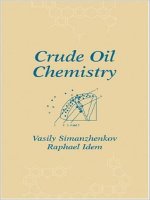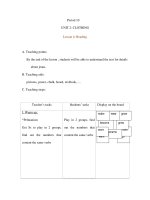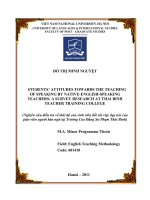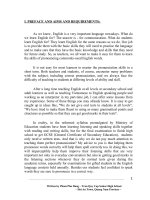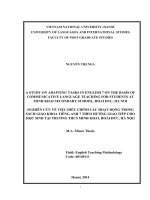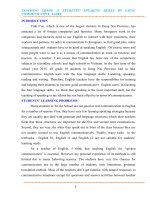Teaching secondary chemistry by keith taber
Bạn đang xem bản rút gọn của tài liệu. Xem và tải ngay bản đầy đủ của tài liệu tại đây (12.09 MB, 401 trang )
free ebooks ==>
www.ebook777.com
www.ebook777.com
free ebooks ==> www.ebook777.com
ASE Science Practice
teaching secondary
C H E M I S T RY
Second edition
Ed i to r: K e i t h S. Ta b e r
free ebooks ==> www.ebook777.com
Titles in this series:
Teaching Secondary Biology
Teaching Secondary Chemistry
Teaching Secondary Physics
978 1444 124316
978 1444 124323
978 1444 124309
The Publishers would like to thank the following for permission to reproduce copyright material:
Photo credits
p.8 Photo Researchers/Alamy; p.13 l cartela – Fotolia; p.57 Philip Johnson; p.169 l 123idees –
Fotolia, r dk/Alamy; p.190 l Andrew Lambert Photography/Science Photo Library, r Paul Straathof,
www.paulslab.com; p.191 John Oversby; p.254 Jean-Claude Revy, ISM/Science Photo Library;
p.271 John Boud/Alamy; p.354 tl Nick Biemans – Fotolia, tr Vera Kuttelvaserova – Fotolia, b
Vincent RUF – Fotolia; p.355 a Holmes Garden Photos/Alamy, b Noam Graizer/Alamy, c F1online
digitale Bildagentur GmbH/Alamy, d Bill Bachman/Alamy, e Powered by Light/Alan Spencer/Alamy.
Every effort has been made to trace all copyright holders, but if any have been inadvertently
overlooked the Publishers will be pleased to make the necessary arrangements at the first opportunity.
Although every effort has been made to ensure that website addresses are correct at time of going to
press, Hodder Education cannot be held responsible for the content of any website mentioned in this
book. It is sometimes possible to find a relocated web page by typing in the address of the home page
for a website in the URL window of your browser.
Hachette UK’s policy is to use papers that are natural, renewable and recyclable products and made
from wood grown in sustainable forests. The logging and manufacturing processes are expected to
conform to the environmental regulations of the country of origin.
Orders: please contact Bookpoint Ltd, 130 Milton Park, Abingdon, Oxon OX14 4SB. Telephone:
(44) 01235 827720. Fax: (44) 01235 400454. Lines are open 9.00 – 5.00, Monday to Saturday, with a
24-hour message answering service. Visit our website at www.hoddereducation.co.uk
© Association for Science Education 2012
First published in 2012 by
Hodder Education,
An Hachette UK Company
338 Euston Road
London NW1 3BH
Impression number 5 4 3 2 1
Year 2016 2015 2014 2013 2012
All rights reserved. Apart from any use permitted under UK copyright law, no part of this publication
may be reproduced or transmitted in any form or by any means, electronic or mechanical, including
photocopying and recording, or held within any information storage and retrieval system, without
permission in writing from the publisher or under licence from the Copyright Licensing Agency
Limited. Further details of such licences (for reprographic reproduction) may be obtained from the
Copyright Licensing Agency Limited, Saffron House, 6–10 Kirby Street, London EC1N 8TS.
Cover photo © BSIP, Laurent/Science photo library
Illustrations by Tony Jones/Art Construction
Typeset in 11.5 ITC Galliard by Pantek Media, Maidstone, Kent
Printed by MPG Books, Bodmin
A catalogue record for this title is available from the British Library
ISBN: 978 1444 124323
www.ebook777.com
free ebooks ==> www.ebook777.com
Contents
Contributors
iv
Introduction
Keith S. Taber
vi
1 Key concepts in chemistry
Keith S. Taber
1
2Introducing particle theory
Philip Johnson
49
3Introducing chemical change
Keith S. Taber
75
4 Developing models of chemical bonding
Keith S. Taber
103
5Extent, rates and energetics of chemical change
Vanessa Kind
137
6Acids and alkalis
John Oversby
183
7 Combustion and redox reactions
Vicky Wong, Judy Brophy and Justin Dillon
199
8Electrolysis, electrolytes and galvanic cells
Georgios Tsaparlis
253
9Inorganic chemical analysis
Kim Chwee Daniel Tan
279
10 Organic chemistry and the chemistry of natural products
Vanessa Kind
303
11Earth science
Elaine Wilson
343
12 Chemistry in the secondary curriculum
Keith S. Taber
369
Index
379
free ebooks ==> www.ebook777.com
Contributors
Judy Brophy graduated in chemistry from Manchester University
before training as a teacher at the Institute of Education. She taught
science and chemistry for many years in inner city (11–18) London
comprehensives, whilst taking an active role in the ASE. Judy
specialised, successfully, in encouraging her A Level students,
especially girls, to aim higher. As a visiting teacher at King’s
College London she passes on her experience to secondary science
PGCE students.
Justin Dillon is professor of science and environmental education
and Head of the Science and Technology Education Group at
King’s College London. After studying for a degree in chemistry he
trained as a teacher at Chelsea College and taught in six inner
London schools until 1989 when he joined King’s. Justin is
co-editor of the International Journal of Science Education and in
2007 was elected President of the European Science Education
Research Association for a four-year term.
Philip Johnson taught chemistry up to A Level for thirteen years
in 11–18 comprehensive schools before joining Durham University
School of Education in 1992. He began researching into the
development of students’ understanding in chemistry while
teaching in schools and continues to do so. His work is published in
international science education research journals.
Vanessa Kind is Senior Lecturer in Education at Durham
University and Director of Science Learning Centre North East.
She has extensive experience of chemical education gained through
teaching in London and Hull, and a previous lectureship at the
Institute of Education, University of London. Vanessa was the
Royal Society of Chemistry’s Teacher Fellow 2001–2002. Her
current research interests include pedagogical content knowledge
for science teaching and post-16 chemistry education.
John Oversby has been a teacher of sciences and mathematics in
Ghana and the UK for over 20 years, and a teacher educator at The
University of Reading for 20 years. He is also an active member of
The Royal Society of Chemistry and Chair of the ASE Research
Committee. He has interests in modelling in science education. He
has been the UK coordinator of a history and philosophy in science
teaching project and is now international coordinator of a
Comenius Climate Change Education network.
iv
www.ebook777.com
free ebooks ==> www.ebook777.com
Contributors
Keith S. Taber taught sciences, mainly chemistry and physics, in
secondary schools and further education, before joining the Faculty
of Education at the University of Cambridge, where he is mostly
working with higher degree students. Whilst teaching, he
undertook doctoral research exploring student understanding of
the chemical bond concept. He was the Royal Society of
Chemistry’s Teacher Fellow in 2000–2001. He has written a good
deal about chemistry and science education, and is editor of the
journal Chemistry Education Research and Practice.
Kim Chwee Daniel Tan started his career as a chemistry teacher in
1990. He has been a faculty member of the (Singapore) National
Institute of Education since 1998. He teaches higher degree courses
as well as chemistry pedagogy courses in the pre-service teacher
education programmes. His research interests are chemistry
curriculum, translational research, ICT in science education,
students’ understanding and alternative conceptions of science,
multimodality and practical work.
Georgios Tsaparlis is professor of science education at University
of Ioannina, Greece. He holds a chemistry degree (University of
Athens) and an M.Sc., and a Ph.D. (University of East Anglia). He
teaches physical chemistry (including electrochemistry) and science/
chemistry education courses. He has published extensively in
science education, his research focus being on structural concepts,
problem solving, teaching and learning methodology, and
chemistry curricula. He was founder and editor (2000–2011) of
Chemistry Education Research and Practice (CERP).
Elaine Wilson is a Senior Lecturer in science education and a
Fellow of Homerton College at the University of Cambridge.
Elaine was formerly a secondary school chemistry teacher who was
awarded a Salters’ Medal for Chemistry teaching. She now teaches
undergraduates, secondary science PGCE students, coordinates a
‘blended learning’ Science Education Masters course and has helped
set up a new EdD course. Elaine has received two career awards for
teaching in Higher Education, a University of Cambridge
Pilkington Teaching Prize and a National Teaching Fellowship.
Vicky Wong taught Science and Chemistry in the UK, Spain and
New Zealand for ten years. She was the Royal Society of Chemistry
Teacher Fellow in 2004–2005 and now works as an independent
science education consultant running training courses for teachers,
writing curriculum materials and undertaking research.
v
free ebooks ==> www.ebook777.com
Introduction
Keith S. Taber
This book is part of a series of handbooks for science teachers
commissioned by the Association for Science Education. This
particular handbook is intended to support the teaching of
chemistry at secondary level (taken here as ages 11–16 years),
whether as a discrete subject or as part of a broader science course.
The book has been written with a particular awareness of the needs
of new teachers and of those teaching chemistry who would not
consider it their specialism within the sciences. However, the book
should prove to be of interest and value to anyone teaching
chemistry topics at secondary level. The book has been written by a
team of authors who collectively have a wide range of experience in
teaching chemistry, supporting and developing teachers of
chemistry, and undertaking research into teaching and learning in
chemistry topics.
It is sometimes easier to characterise something by explaining
what it is not. This book is not a chemistry textbook for teachers,
although inevitably it discusses chemistry content as part of the
process of describing and recommending approaches to teaching
the subject. There are many good chemistry books available at
various levels, and any teacher who is concerned about their
knowledge and understanding in aspects of chemistry should first
do some work to develop their own subject knowledge before
considering approaches to teaching. So-called ‘pedagogic content
knowledge’ will only be sound when we are building on subject
knowledge that is sound (else we become very effective at teaching
poor chemistry).
The handbook does not set out to act as a teaching guide for any
particular curriculum or syllabus. We intend the book to be equally
useful across different courses: whether the course is arranged as a
set of traditional topics or organised in some other way, for example
teaching concepts through the contexts of major areas of
application of chemistry such as food, transport, fabrics, etc. The
book is not tied to a particular stream or ability level of student. In
some places chapters make explicit suggestions for differentiating
between different groups of students, but you should always
consider how the advice given here can best inform the teaching of
your particular classes.
Nor does the book set out to be a manual for teaching chemistry
in the sense of providing comprehensive coverage of all content that
might potentially be included in a secondary chemistry course.
Such a manual would inevitably be both voluminous and very
quickly out of date as chemistry and chemistry teaching move on.
vi
www.ebook777.com
free ebooks ==> www.ebook777.com
Introduction
Ideas for effective chemistry teaching
The philosophy behind the present book is that it is more important
to inform teachers about effective teaching approaches than to train
them to apply specified teaching schemes in particular topics. Some
of the recommendations we offer in the handbook are based on a
good deal of classroom experience and draw on specific research
into students’ learning difficulties and effective innovations in
teaching. The specific suggestions made for teaching these aspects
of the subject can certainly be considered as the best researchinformed advice currently available to teachers.
However, teaching is a contextualised process: students, facilities,
curriculum requirements and so much more can make a difference
to what counts as good teaching in a particular classroom on a
particular day. So just as important as the specific suggestions for
teaching particular concepts is the range of approaches adopted by
authors across the chapters. Drawing upon the range of teaching
and learning activities described here can inform the development
of teaching that is both varied and responsive to the needs of
particular students and classes. Although not everything that could
possibly be covered is included in the book, the thinking behind the
examples that are presented here offers the basis for developing
effective teaching that can be adopted across chemistry teaching
(and often well beyond).
Teaching about the nature of chemistry
In accordance with the philosophy outlined above, the reader will
find a varied set of chapters included in the book. For example,
features of the nature of chemistry as a science are highlighted in
some chapters. Teaching about the nature of science (which has
sometimes been referred to as ‘how science works’), which
recognises how all students need to understand science (i.e. should
be scientifically literate) for their role as citizens (as consumers,
voters, etc.), has become increasingly important. Such a perspective
needs to inform all science teaching and readers may wish to think
how the ideas highlighted in a number of the chapters here (such as
the nature and role of models in developing understanding of the
world) can be more widely applied.
Another key difference between the chapters is the centrality of
the topics discussed. The first five chapters set out key ideas that are
needed to understand any area of chemistry, whereas the other
chapters stand alone to a much greater extent. It is also useful to note
that while almost all of the chapters are clearly about chemistry, the
vii
free ebooks ==> www.ebook777.com
INTRODUCTION
chapter about Earth science overlaps strongly with several other
sciences, and in particular draws on geology. Given the increasing
importance of interdisciplinary work in science and – even more so
– the importance of understanding the environment in science and
in society more widely, this chapter reminds us that chemistry links
with, builds upon, and feeds into, a wide range of scientific work.
A final difference between chapters that will be very obvious to
readers is the extent to which practical work features. It is said that
chemistry is a practical subject. This is certainly true, but – as a
science – chemistry is just as much a theoretical subject: it is the
interplay of theory and evidence that is at the heart of scientific
work. Chemistry as a science is based upon observations that lead
to the development of categories and the identification of patterns,
and to ways of making sense of, and understanding, the
phenomena. This involves the construction of models and theories,
which can motivate empirical investigations that can then inform
further rounds of theorising and experimentation. In particular,
much of chemistry as a science can be considered to be about
building models and selecting those that are useful to scientists
despite inevitably having limited ranges of application. The notions
of acids (Chapter 6) or oxidation (Chapter 7) certainly reflect this,
being concepts that are the products of human imagination,
designed to reflect the patterns found in nature and to have utility
to chemists as tools for thinking, explaining, predicting and so
supporting practical and technological work. Understanding
chemical ideas in this way, as creative products of scientific work
(rather than simply being descriptions of the way the world is),
should help students make sense of how chemists have modified
these concepts over time (as described in the case of acids in
Chapter 6), and why sometimes we seem to operate with a range of
not entirely consistent models (oxidation in terms of oxygen or
electrons: Chapter 7; oxidation in terms of oxidation states:
Chapter 9).
An activity which illustrates this general point in relation to
particle theory (the topic of Chapter 2) is included in a publication
available from SEP (the Science Enhancement Programme, details of
which are given in the ‘Other resources’ section at the end of this
introduction). The first of two group-work tasks in this activity
‘Judging models in science’ asks students to consider two types of
particle models – particles like tiny hard billiard balls; particles as
molecules with ‘soft’ electron clouds – and to consider which model
better explains a range of evidence based on the observable properties
of matter. Students will find that each model is useful for explaining
some phenomena, but neither fits all the evidence – and of course
both models are still found useful in science.
viii
www.ebook777.com
free ebooks ==> www.ebook777.com
Introduction
A key aspect of this Janus-faced nature of chemistry (looking to
both the phenomena and the theories) is that chemistry is discussed
in terms of the macroscopic/molar/phenomenal level and in terms of
submicroscopic particle models which are used to make sense of
those phenomena. These models exemplify the nature of science
(offering an extremely powerful explanatory scheme for making
sense of the nature of the material world), but are known to be
challenging for students.
A central feature of the way chemistry is presented and discussed
in classrooms is the set of representations (such as formulae and
chemical equations) used. This is often seen as a third ‘level’ distinct
from the molar and submicroscopic levels, but is more helpfully
understood as a specialised language that allows us to shift between
those two levels (see Chapter 3). Translating between observable
phenomena, symbolic representations and theoretical models is a
key part both of teaching, and learning, chemistry.
Practical work and ‘experiments’ in
chemistry teaching
Given the nature of chemistry as a discipline, and of school
chemistry as a curriculum subject, it is essential that students are
introduced to the phenomena that the theories and models are
meant to help us understand. Without experiencing these
phenomena, there is little motivation for adopting the theoretical
ideas. Within school science, practical work has long been seen as a
key part of chemistry lessons in many countries (and especially in
the UK). Yet research also suggests that a good deal of the practical
work undertaken by students has limited impact on learning (or
even on student motivation to continue studying the subject).
Readers should consider carefully whether practical work
undertaken is going to be the most effective way of meeting the
purposes of teaching. In some cases this will certainly be so. So the
chapter on inorganic analysis, an area of secondary chemistry that is
not always given as much attention as it once was, is largely
developed around practical work that students can carry out. This
makes sense, as the aims of teaching this topic include the ability to
carry out analytical procedures and interpret bench observations to
identify particular chemical species present. Other chapters vary
considerably in the amount of laboratory practical work
recommended. In some cases teacher demonstrations are
recommended as being more effective ways of ensuring students can
be helped to appreciate the chemical interpretations of observations
ix
free ebooks ==> www.ebook777.com
INTRODUCTION
– as a teacher you can draw students’ attention to the chemically
relevant and away from the salient but incidental. In some topics
alternative forms of engaging, active learning are suggested to help
students learn concepts not easily appreciated from the laboratory
work possible in school contexts. Ultimately, however, theory and
practical experience both have important roles to play and need to be
coordinated across secondary school learning.
One specific issue that has vexed me in this context is the use of
the term ‘experiment’ to describe school science practical work.
Very few chemistry practicals carried out in most schools have any
genuine claim to be experiments (authentic investigations to test
out hypotheses, rather than to illustrate what is already set out as
target knowledge to be learnt), and using the term experiment
loosely may undermine learning about the nature of science, when
we know that students commonly use technical terms such as
‘experiment’, ‘theory’, ‘proof’ and so forth in very vague and
inconsistent ways. However, within the culture of school chemistry
the term experiment is often used for any laboratory practical
activity, especially one that is undertaken by students (rather than
being a demonstration). Some authors here have followed the
common usage and referred to laboratory practical activities as
experiments. This is fine in talk among teachers and technicians,
but it may be wise to consider carefully which practical activities
should be presented to students as experiments. It is probably best
limited to those where they are genuinely testing some kind of
hypothesis – where students are seeking to discover something they
do not actually already know.
MM Ensuring safety during practical work
Many standard chemistry practicals have been carried out safely in
schools for decades and there have seldom been serious accidents.
Yet clearly there are particular potential hazards involved in some
practical work. It is important to keep the potential risks of practical
activities (whether observed by, or undertaken by, the students) in
perspective, yet to remember that student safety must be your
paramount concern. In this book, the margin icon shown here is
used to alert you to particular safety issues that you should be aware
of. Recommended activities are considered suitable for classroom
use by the authors. However, assessing risk is not just about the
activity, but also the people and the conditions. The same practical
may be viable with some teaching groups and not others.
It is, therefore, very important to undertake careful risk
assessments before deciding to do any practical activities in the
x
www.ebook777.com
free ebooks ==> www.ebook777.com
Introduction
classroom. Your risk assessment needs to consider the experience
and skills of the person(s) carrying out the activity (teacher or
students), how responsible the particular students are and the
facilities available in the teaching room (presence of a fume
cupboard, adequate ventilation, sufficient access to sinks, plenty of
space for students to move around, support of teaching assistants,
assistance of a qualified technician, etc.)
For any practical activity (including teacher demonstrations) the
teacher should carry out a risk assessment. This might include:
MM
MM
MM
checking the model risk assessment supplied by their employer
(this may be supplied by another agency, such as CLEAPPS or
SSERC in the UK, to which the employer subscribes) and
adjusting the model risk assessment as appropriate.
referring to the hazards of the starting material and the products
by consulting safety data sheets provided by the supplier, and
adjusting the model risk assessment as appropriate,
consulting more experienced teachers or experienced technicians.
As a result, the significant findings should be recorded and the
appropriate control measures implemented. Whatever the outcomes
of a risk assessment, including the risk of annoying hard-working
technical staff, you should always be prepared to suspend or cancel
laboratory work during a lesson if at any point you judge that
student behaviour or some other factor makes continuing unwise.
The structure of the book
The book contains twelve chapters. The first three discuss the
teaching of the most basic chemical ideas, which underpin all other
chemistry topics. These are ideas that will need to be met early on
in the secondary school, but will be developed in more
sophisticated ways throughout the secondary years. Chapters 4 and
5 discuss other fundamental ideas which build upon those
discussed in Chapters 1–3, and provide the basis for the level of
theoretical exploration of chemistry expected of many uppersecondary level classes (as well as setting out the theoretical basis
that is developed in post-secondary study). The next six chapters
draw upon, and often assume knowledge of, these basic ideas, but
need not necessarily be taught in the order they appear in the
handbook. The final chapter has a slightly different flavour; it
reflects upon how decisions are made about which chemistry topics
should be a part of the secondary education for different groups of
students. For readers in some contexts such decisions will be made
centrally by curriculum authorities, but in many teaching contexts
xi
free ebooks ==> www.ebook777.com
INTRODUCTION
there may be important decisions to be made about which science
topics should be part of a core curriculum, and which can be seen as
either possible enrichment or as important for some, but not all,
groups of students.
1 Key concepts in chemistry
2 Introducing particle theory
3 Introducing chemical change
4 Developing models of chemical
bonding
5 Extent, rates and energetics of
chemical change
6 Acids and
alkalis
8 Electrolysis,
electrolytes and
galvanic cells
9 Inorganic
chemical
analysis
7 Combustion and
redox reactions
11 Earth science
10 Organic chemistry
and the chemistry of
natural products
12 Chemistry in the
secondary curriculum
xii
www.ebook777.com
free ebooks ==> www.ebook777.com
Introduction
MM The structure of the chapters
As suggested above, the nature of the eleven topic-based chapters in
this book reflects the diversity of topics found in a chemistry
course, as well as the different teaching approaches judged worth
recommending by the authors who have particular expertise in
those topics. However, all of these chapters include a number of
common features. Each chapter is divided into sections according
to main subsections of the chapter topic, and each includes a
schematic diagram of the chapter structure. Each chapter offers
guidance on a route through the topic. These chapters also discuss
the prior knowledge and relevant experience that students will
bring to the study of the topic at secondary level, as well as
highlighting the common learning difficulties and alternative
conceptions that students are known to have in the topic. Although
the authors here can offer guidance on the likely range of prior
knowledge and common alternative conceptions to be found in
many classes, each group of students is different, and – indeed –
each learner is an individual with their own personal understanding
of the world and their own way of interpreting what they are taught
in chemistry classes.
This is something I am well aware of from my own work, where
I have spent a good deal of time asking secondary-age students to
tell me about their understanding of various science topics. There
are some very common alternative ideas (alternative conceptions or
misconceptions) that are found in just about any class. For example,
it is very likely that in any upper secondary science or chemistry
class you teach, at least some (and in many classes it will be most) of
the students think that chemical reactions occur so that individual
atoms can fill their electron shells. (If you cannot see what is wrong
with that idea, then you may find Chapter 4 quite interesting.)
However, it is also the case that if you spend enough time asking
students to tell you their ideas relating to science topics, you are likely
to uncover some idiosyncratic notion they hold which is at odds with
accepted scientific knowledge and which you have never heard
suggested before. Student individuality and creativity is such that this
is likely to remain the case even when you have been teaching
chemistry for some decades! Some examples of student thinking
about chemistry topics can be found on the ECLIPSE project website
(full details of which are given in the ‘Other resources’ section at the
end of this introduction), offering a taste of the diverse and often
unexpected ways that different learners make sense of the topics they
meet in school science lessons. (Note, the icon here is used in the
margin where references are made to useful websites.)
xiii
free ebooks ==> www.ebook777.com
INTRODUCTION
As what students already think is a strong determinant of what
they will learn in your lessons, it is worth spending some time
exploring their ideas and in particular undertaking diagnostic
assessment at the start of major topics to check on prior learning
and elicit any strongly held alternative conceptions. In an ideal
world teachers would have time to talk at length to each of their
students. More realistically, ideas can be explored through openended classroom discussion that invites students’ ideas in an
accepting way and explores their consequences (and relationship
with available evidence), before ‘closing down’ discussion to present
the scientific models. This presentation of the ‘scientific story’ can
then be done in ways that anticipate student objections and
emphasise the reasons for the scientific explanations being adopted
in the scientific community – especially where these explanations
contradict students’ own thinking. Classroom materials for
diagnostic assessment have been published in many science topics
and some are referred to in this volume.
The chapters here draw upon research evidence, although in
common with other handbooks in the series, the chapters do not
include in the text references to the research literature. However,
recommendations for further reading and suggestions for resources
likely to be found useful by teachers are listed at the end of chapters.
Keith S. Taber
Cambridge, 2012
Other resources
MM Books
The ASE Guide to Secondary Science Education (Martin Hollins,
editor) offers a broad range of advice and information for those
teaching science in secondary schools. ASE Publications.
An introduction to how students learn in chemistry and the
nature and consequences of their alternative ideas, as well as a range
of classroom resources to diagnose student ideas, can be found in
Chemical Misconceptions – Prevention, Diagnosis and Cure. Taber,
K.S. (2002). London: Royal Society of Chemistry. Volume 1:
Theoretical background; Volume 2: Classroom resources.
To explore further ideas for teaching about the nature of science,
readers might refer to the companion handbook in this series,
Teaching Secondary How Science Works. Vanessa Kind and Per
Morten Kind (2008). London: Hodder Education.
xiv
www.ebook777.com
free ebooks ==> www.ebook777.com
Introduction
CLEAPSS provides support for practical work, and in particular
health and safely information for school science. CLEAPSS is the
source for such useful resources as the Secondary Science Laboratory
Handbook and Secondary Science Hazcards (providing safety
information and model risk assessments for handling chemicals).
www.cleapss.org.uk
For a research-based discussion of effective practical work in
school science see Practical Work in School Science: A Minds-on
Approach. Abrahams, I. (2011). London: Continuum.
The group-work activity ‘Judging models in science’ is included
in Enriching School Science for the Gifted Learner. Taber, K.S. (2007).
London: Gatsby Science Enhancement Programme. Available from
‘Mindsets Online’: www.mindsetsonline.co.uk
MM Websites
An introduction to the common alternative ideas
(‘misconceptions’) that students often develop in chemistry is
provided in Kind, V. (2004). Beyond Appearances: Students’
Misconceptions about Basic Chemical Ideas (2nd edn). London: Royal
Society of Chemistry. Available at: www.rsc.org/Education/
Teachers/Resources/Books/Misconceptions.asp
The Royal Society of Chemistry provides a wide range of resources
to support chemistry teaching, which may be searched at:
www.rsc.org/learn-chemistry
Examples of how students think about and explain chemistry (and
other science) topics can be found at the ECLIPSE (Exploring
Conceptual Learning, Integration and Progression in Science
Education) project website:
www.educ.cam.ac.uk/research/projects/eclipse
A range of resources for chemistry teachers recommended by
colleagues on two email discussion lists (Chemistry-Teachers@
yahoogroups.co.uk and ) are listed at:
/>The magazine Education in Chemistry, published by the Royal
Society of Chemistry, includes a regular feature called ‘Exhibition
Chemistry’ offering ‘ideas for chemistry demonstrations to capture
the student’s imagination’. These are accompanied by a video of the
demonstration which can be viewed on the web:
www.rsc.org/Education/EiC/topics/Exhibition_chemistry.asp
xv
free ebooks ==> www.ebook777.com
This page intentionally left blank
www.ebook777.com
free ebooks ==> www.ebook777.com
1
Key concepts in chemistry
Keith S. Taber
1.1 Stuff, matter, materials
Defining chemistry as a science
MM Substances
MM An empirical view of substances
MM A theoretical view of substances
MM
1.2 Mixtures
MM Dissolving and
recrystallising
MM Separating salt from
sand
MM Chromatography
MM Formulating mixtures
1.3 Elements and
compounds
MM Teaching about
elements and
compounds
MM The chemist’s elemental
analyser
MM The periodic table of
the elements
MM Revising the periodic
table
1.4 Change in
chemistry – the
concept of reactions
MM Chemical and physical
change – a useful rule
of thumb?
MM Teaching about
chemical and physical
change
MM Diagnosing student
thinking about chemical
and physical change
1.5 Stoichiometry
1.6 Moles –
measuring quantities
in chemistry
MM The chemist’s dozen
MM Range of moles
problems
MM Coda
MM Choosing a route
This chapter will present key ideas that will be taught and
developed through a spiral curriculum. Increasingly advanced
treatments will be revisited throughout the secondary years in
different contexts. This is important because many of the ideas met
in chemistry are abstract, unfamiliar and even counter-intuitive.
Learners therefore need time to come to terms with these ideas; to
1
free ebooks ==> www.ebook777.com
key concepts in chemistry
explore them and become familiar with them. Few students will be
able to master these ideas when first meeting them, so it is
important that the ideas are carefully introduced and then later
reviewed and reinforced in a variety of contexts. Luckily, chemistry,
as a subject, supports this teaching approach as many of the key
ideas are relevant to teaching and learning across all topics. A
balance will be needed between introducing new materials and
revisiting previous teaching. It is easy to overload students’ working
memories, as they can only keep a limited amount of new
information in their minds at any time. However, effective and
meaningful learning will require students to relate teaching to their
developing understanding of the subject. The key is to recognise
that while ideas are still novel (and often somewhat strange) they
will place a demand on the learner, but if they are regularly
reinforced in various contexts, then over time these increasingly
familiar ideas will shift from being an additional load on memory
to acting as suitable support (‘scaffolding’) for new learning.
It is recommended, therefore, that after a major new idea is
introduced (the distinction between chemical substances and
mixtures of substances, say), you should look for opportunities to
review the idea as often as possible over the next few weeks and
months. Initially treat the reviews as if dealing with new material
(for some students they will be received that way) and over time
shift your approach to treating the ideas as taken for granted within
the community of the chemistry class. Seeking regular formative
feedback (‘Jilly, can you remember what we called a substance with
only one type of atom?’; ‘Vijay, could you remind the class what we
mean by a chemical reaction?’) will provide guidance on how
quickly such shifts are possible with particular classes.
Similar advice would be appropriate to many subjects, but in
chemistry we have to deal with two particular complications that
do not always apply in other subjects. As some of our key ideas are
abstract and cannot be demonstrated directly, it is difficult to
explain them clearly without reference to other equally abstract
ideas. For example, consider the idea that a chemical change
produces different chemical substances. To understand this
statement, a student would already need to have a good grasp of the
concept of chemical substances, so it would seem chemical
substance needs to be introduced first. Yet understanding a
chemical substance as something that retains its identity through
phase changes (such as ice becoming water) to some extent requires
one to already have some notion that such changes are not
considered as chemical changes. Of course, a decision has to be
made about which ideas should be considered most suitable as a
starting point, but students will not be in a position to appreciate
2
www.ebook777.com
free ebooks ==> www.ebook777.com
1.1 Stuff, matter, materials
these concepts fully when first introduced. So learning in chemistry
is iterative, involving some ‘bootstrapping’ of partially understood
concepts, one upon another.
Perhaps this circularity can be avoided to some extent by defining
a pure substance differently – in terms of structure at the molecular
level. Yet learning about ‘particle models’, as we will see in this and
the subsequent chapters, is challenging for students and we again
run into the way ideas are intimately interlinked. Finding a simple
‘particle’ level definition of a pure substance that would apply
unproblematically to all substances (such as neon, oxygen, water,
common salt, sulfur, sugar and copper) might be a challenge for
any teacher!
This chapter is organised, as it needs to be, as a linear
presentation of topics. In one sense this is a logical sequence to
follow in teaching, as it builds up the complexity of the ideas.
However, while I would advise teachers to try to follow something
like this sequence, it is more important to realise that whatever
order is chosen, the effective teaching of these ideas will not be
achieved in a single pass through.
1.1Stuff, matter, materials
MM Previous knowledge and experience
Students will have had experience with materials as part of their
primary education, as well as from their everyday experience of the
world. Students are likely to be familiar in particular with the ideas of
solids, liquids and (probably) gases, although their concepts here may
be limited and imprecise (and talking about materials in this way, as
being ‘solids’, ‘liquids’ and ‘gases’ may not be helpful, as will be
explained in Chapter 2). Some may have met the particle model of
matter and may be familiar with simple representations of the states
of matter at a submicroscopic scale, though they are unlikely to have a
good grasp of the actual scale at which these particles are considered
to exist, nor a strong appreciation of the significance of the models.
MM A teaching sequence
OO
Defining chemistry as a science
Definitions in science are notoriously unhelpful. They tend either to
be very vague, too exclusive (i.e. seeming to omit things that should
be included) or so technical that they are only useful to someone
who already has a good understanding of what is being defined.
3
free ebooks ==> www.ebook777.com
key concepts in chemistry
Chemistry is usually defined in terms of being about the nature,
properties and structure of matter, or about the properties and
interactions of different substances. While not inaccurate, such
definitions are of limited value to students until they have already
started to see ‘matter’ in chemical terms and to understand what
chemists mean by ‘substances’.
Chemistry is about the ‘stuff’ around us and about how we can
think about this stuff in scientific terms. As a science, chemistry
sets about analysing stuff in systematic ways and this often means
working with simplifications and generalisations – at least as
starting points and ‘first approximations’. The science of chemistry
involves building up a body of theory: a collection of principles,
laws and models that can be used to make sense of, and so explain
and predict, the properties of matter.
These are important points, as a student cannot be considered to
understand chemistry in any depth unless she or he appreciates that,
as a science, its central ‘contents’ are not the phenomena in nature,
but the theoretical constructs people have developed to explain
those phenomena. Most chemists are very interested in the
phenomena themselves – we tend to be fascinated by the colour
changes, the ability to produce smells and bangs and so forth.
Students usually like this aspect of the subject, although for most
the original fascination with smells and bangs is unlikely to last
throughout secondary education if it is based purely on observing
phenomena. What makes chemistry a science, and makes it a science
that continues to fascinate students, is the ability to organise and
explain the phenomena in terms of models of great explanatory
strength; models that with some modification can be applied across
the wide range of substances and reactions met in school science
(and of course beyond).
OO
Substances
One of the major simplifications adopted in chemistry is to focus
on substances. This is a simplification because, in our normal
environment, few of the materials we commonly come across are
strictly ‘substances’ in the chemical sense. Figure 1.1 sets out the
relationship between some key ideas in chemistry. So where ‘matter’
is a general term for stuff, we tend to use the term ‘materials’ for
well defined samples of stuff that we can work with – glass, wood,
sodium carbonate (washing soda), poly(ethene), diamond, sea
water, paint, etc. From a technological perspective, these materials
may have a similar status (different types of stuff that can be
obtained, worked in various ways or used in different applications),
4
www.ebook777.com
free ebooks ==> www.ebook777.com
1.1 Stuff, matter, materials
but to a chemist they have rather different status. Materials may be
pure substances like diamond or sodium carbonate, or mixtures
such as air or paint. The use of the term ‘mixture’ is another
simplification, as something like wood is more complicated –
although it contains many substances, they are not simply mixed in a
random way, but built into a complex structure. Some manufactured
materials are also composite, such as ‘fibreglass’, which contains
fibres of glass embedded in a polymer (plastic).
Matter
is a general term for any stuff
MM
Materials
are well defined samples of stuff
MM
Mixtures
contain several substances mixed together
Substances
are chemically pure samples – one type of
stuff
MM
MM
Elements
are considered fundamental types of
substance in chemistry
MM
MM
Compounds
are pure substances that can be synthesised
from combinations of elements
Figure 1.1 How some key terms are understood in chemistry
So most common materials in our environment, such as air, sea
water, earth, wood and even steel, are not substances. This is a
simple point but one which is not trivial for students. A key issue
here in the minds of some students is the notion of ‘natural’
materials. For a chemist, natural products are those that derive from
animal or vegetable sources, but are not considered to make up an
intrinsically distinct type of stuff from other materials. (However,
chemical terminology still retains vestiges of earlier thinking that
living matter had some special vital essence, in our use of the terms
‘organic’ and ‘inorganic’.)
5
free ebooks ==> www.ebook777.com
key concepts in chemistry
For many lay people natural materials are considered to be
intrinsically better (for example, safer) than ‘synthetic’ or man-made
materials. The assumption seems to be that nature knows best, and
man less so. From a scientific perspective, man is part of nature and
any material that can be made by man is just as natural as anything
secreted, excreted or extracted from a living organism. Indeed there
are many berries, fungi, insects and amphibians that produce
substances which are harmful or even lethal to people, whereas
most synthetic products produced by chemists are subject to
extensive safety testing before being allowed onto the market. Many
natural products that were once difficult to obtain (for example,
those requiring expensive processes to extract and purify tiny
quantities of a substance present in living things) can now be
synthesised much more effectively, and of course their chemical
behaviour is unrelated to their origins.
As teachers, we need to be aware that many of our students may
have absorbed at some level the notion of ‘natural-good, syntheticbad’ and be prepared to challenge the supposition without ignoring
or underplaying how many synthetic materials can be used to do
harm, in weapons for example, and may bring significant
environmental costs in manufacture or disposal.
A closely related idea is that of purity. When buying orange juice
to drink, for example, we expect it to be ‘pure’ in the sense of just
being material squeezed from oranges, and not including dead flies,
sawdust or the farmer’s finger nail cuttings. To assure the potential
buyer of this, the manufacturer may well claim to be selling ‘100%
pure orange juice’, and in the context of selling and buying a drink
this makes perfect sense.
However, students will need to be taught that no matter how
pure our orange juice is in terms of only being juice from oranges,
it is far from being a ‘pure substance’ in chemical terms. Orange
juice is mostly water, but contains a wide range of other substances
including fruit sugar, vitamin C, citric acid, various amino acids
and flavonoids that make oranges taste different from lemons or
grapefruits. Chemically, orange juice is a mixture of a lot of
different substances, even though it is a natural product. A key
distinction to be introduced and reiterated in teaching the subject,
then, is that between materials which can be understood in
everyday terms (orange juice is a different material from the glass,
paper or ceramic cup we may drink it from) and the constituent
substances that chemists analyse such materials into.
So the task of the chemistry teacher is to find a way to justify
considering iron but not steel, methane but not petroleum, cellulose
but not wood, sucrose but not honey, vitamin C but not orange juice,
and so on, as substances. As this is a difficult distinction for those
6
www.ebook777.com
free ebooks ==> www.ebook777.com
1.1 Stuff, matter, materials
new to the subject, it is useful to have a wide range of examples that
can be used when explaining the idea to the students.
However, the examples by themselves only seem persuasive to
those of us who already appreciate the difference between materials
in general and those particular materials that are substances.
Students will have to have good reasons to see this as a meaningful
and important distinction. There would seem to be two different
approaches to thinking about what we mean by substances in
chemistry: one of these is highly empirical and the other more
theoretical. Both approaches offer challenges for the teacher but
also a considerable opportunity to teach about the nature of science
(‘how science works’).
OO
An empirical view of substances
From a chemical perspective, materials are either pure samples of a
single substance or a mixture of substances. When a material is a
mixture, it can in principle be separated into its components. There
are a number of common techniques that can be used to separate
different classes of mixtures, and a mixture that can be separated by
one separation technique will not necessarily be separated by
another. For example, if sand is mixed with salt, it can be separated
by dissolving (the salt) and filtering (Figure 1.2), but this process
glass rod
filter paper
salt solution
stirred
mixture of
sand, salt and
water
sand
water
filter funnel
salt solution
heat
Figure 1.2 Separating sand and salt – salt is recovered by evaporation
after dissolving
TS Chemistry
01.03 and filtering
7
free ebooks ==> www.ebook777.com
key concepts in chemistry
will not work if the sand is mixed with iron filings. Conversely,
sand can be separated from iron filings by using a magnet, but this
will not have an effect on a sand/salt mixture. Laboratory exercises
in this area can easily become somewhat artificial: for example
giving students a deliberately prepared mixture of sand and salt for
them to separate. That is different from being able to take an
unknown material, find out if it is a mixture and – if so – separate it
into its components. That was the kind of challenge faced by Marie
and Pierre Curie when they carried out their work identifying new
chemical substances (the elements radium and polonium).
Figure 1.3 Marie
Curie has the
distinction of
having been
awarded Nobel
Prizes for her
contributions to
both chemistry and
physics
It is often possible to recognise a mixture because mixtures usually
do not have a distinct temperature at which they melt/freeze or boil/
condense (see Chapter 2). Having identified a material as being a
mixture, it is then possible to subject it to the battery of separation
techniques available to the chemist. So, for example, consider a
liquid that was considered to be a mixture (because a sample had
been found to boil over a range of temperatures). It may be that if
the liquid is heated, one component of the mixture will evaporate,
leaving a solid residue (for example, this would happen with salt
solution). However, it is also possible that all of the mixture would
boil off. If a fractional distillation apparatus were set up (Figure
1.4) and the components of the mixture were found to have very
different boiling points, it would be possible to separate them by
carefully collecting condensate from vapour produced at different
temperatures. If, however, the components have similar boiling
temperatures, separation by this technique will prove difficult.
Perhaps another technique, such as a form of chromatography,
might separate the components in such a case.
8
www.ebook777.com
